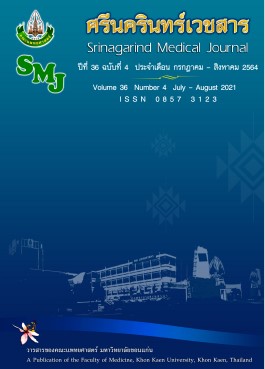Risk Factors Influencing Seroma Formation after Modified Radical Mastectomy
Keywords:
Breast cancer; Seroma; Modified Radical MastectomyAbstract
Background and Objectives: Many articles about seroma formation after Modified Radical Mastectomy (MRM) were published describing incidence and risk factors. No definite significant risk factors were identified as well in Udonthani Cancer hospital. The purpose of this study was to identify factors significantly associated with Seroma formation after MRM.
Method: Retrospective review data of breast cancer patients who under went MRM since August 1, 2014 to October 31, 2017 were collected for identifying significant risk factors influencing seroma formation and statistically calculated by multiple logistic regression analysis.
Result: During the studied period, 303 patients data were reviewed. The incidence of seroma formation was 22.77%. The only significant risk factor influencing Seroma formation was after 48 hrs. with a total drainage volume of more than 200 ml.
Conclusion: The significant risk factor was after 48 hrs. with a total drainage volume of more than 200 ml. the doctor who performed the surgery and the caregiver personnel should be aware of the mentioned risk factors in order to reduce complications and for maximum security for patients.
References
2. Srivastava V, Basu S, Shukla VK. Seroma formation after breast cancer surgery: What we have learned in the last two decades. J of Breast Cancer 2012; Available from http://dx.doi.org/10.4048/jbc.2012.15.4.373. [Accessed November 24, 2017].
3. Say C, Donegan W. A biostatistical evaluation of complications from mastectomy. Surg Gynecol Obstet 1974;138: 370-376.
4. Aitken DR, Minton JP. Complications associated with mastectomy. Surg Clin North Am 1983; 63(6): 1331-1352.
5. Pogson CJ, Adwani A, Ebbs SR. Seroma following breast cancer surgery. Eur J Surg Oncol 2003; 29(9): 711-717.
6. Murphey DR Jr. The use of atmospheric pressure in obliterating axillary dead space following radical mastectomy. South Surg 1947;13(6): 372-375.
7. Kuroi K, Shimosuma K, Taguchi T, Lmai H, Yamashiro H, Ohsumi S, et al. Evidence-Based Risk Factors for Seroma Formation in Breast Surgery. Jpn J Clin Oncol 2006; 36(4): 197-206.
8. Burak WE Jr, Goodman PS, Young DC, Farrar WB. Seroma formation following axillary dissection for breast cancer: Risk factors and lack of influence of bovine thrombin. J Surg Oncol 1997; 64: 27-31.




